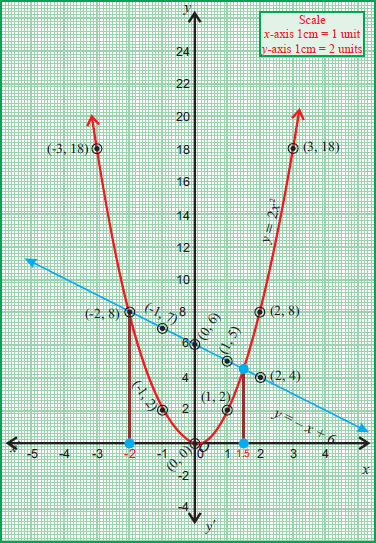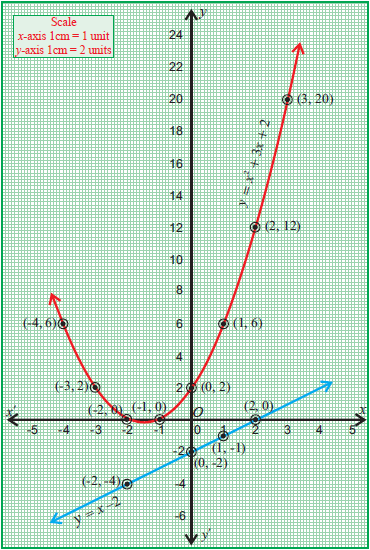LINEAR QUADRATIC SYSTEMS
A linear quadratic system is a system containing one linear equation and one quadratic equation which may be one straight line and one parabola, or one straight line and one circle.
Example 1 :
Solve y = 2x² and y = - x + 6 graphically.
Solution :
First let us make a table of values to graph y = 2x²

We can get the following points from the table.
(–3, 18), (–2, 8),(–1,2), (0, 0), (1, 2), (2, 8), (3, 18) ----- (1)
Now, let us make a table of values to graph y = -x + 6

We can get the following points from the table.
(–1, 7), (0, 6), (1, 5), (1, 5), (2, 4) ----- (2)
Plotting the points which we have in (1) and (2), we get the graph of y = 2x² and y = -x + 6

From the graph, the points of intersection or the two solutions for the given system are
(-2, 8) and (1.5, 4.5)
Example 2 :
Solve y = x² + 3x +2 and y = x - 2 graphically.
Solution :
First let us make a table of values to graph y = x² + 3x +2

We can get the following points from the table.
(–4, 6), (–3, 2), (–2, 0), (–1, 0), (0, 2), (1, 6), (2, 12) and (3, 20) ----- (1)
Now, let us make a table of values to graph y = x - 2

We can get the following points from the table.
(-2, -4), (0, -2), (1, -1), (2, 0) ----- (2)
Plotting the points which we have in (1) and (2), we get the graph of y = x² + 3x +2 and y = x - 2

In the above graph, the straight line y = x - 2 does not intersect y = x² + 3x +2.
Hence, there is no solution for the given system.
Example 3 :
Draw the graph of y = 2x² and hence solve 2x²+x-6 = 0.
Solution :
First let us make a table of values to graph y = 2x²

We can get the following points from the table.
(–3, 18), (–2, 8),(–1,2), (0, 0), (1, 2), (2, 8), (3, 18) ----- (1)
Now, let us take the quadratic equation 2x²+x-6 = 0.
Form the first equation, we know y = 2x².
So, plugging 2x² = y in (2x²+x-6 = 0), we get
y + x - 6 = 0
y = -x + 6
Now, let us make a table of values to graph y = -x + 6

We can get the following points from the table.
(–1, 7), (0, 6), (1, 5), (1, 5), (2, 4) ----- (2)
Thus, the roots of 2x² + x - 6 = 0 are nothing but the x - coordinates of point of intersection of y = 2x² and y = -x + 6.
Plotting the points which we have in (1) and (2), we get the graph of y = 2x² and y = -x + 6

In the graph above, the points of intersection of the line and the parabola are
(-2, 8) and (1.5, 4.5)
The x-coordinates in the points of intersection are -2 and 1.5.
Hence, the two solutions of the equation 2x²+x-6 = 0 are
-2 and 1.5
Example 4 :
Draw the graph of y = x² + 3x + 2 and use it to solve the equation x² + 2x + 4 = 0.
Solution :
First let us make a table of values to graph y = x² + 3x + 2

We can get the following points from the table.
(–4, 6), (–3, 2), (–2, 0), (–1, 0), (0, 2), (1, 6), (2, 12) and (3, 20) ----- (1)
Now, let us take the quadratic equation x²+ 2x + 4 = 0
x²+ 2x + 4 = 0
x²+ (3x-x) + (2+2) = 0
x²+ 3x + 2 - x + 2 = 0
Form the first equation, we know y = x² + 3x + 2.
So, plugging x² + 3x + 2 = y in (x²+ 3x + 2 - x + 2 = 0), we get
y - x + 2 = 0
y = x - 2
Now, let us make a table of values to graph y = x - 2

We can get the following points from the table.
(-2, -4), (0, -2), (1, -1), (2, 0) ----- (2)
Thus, the roots of x² + 2x + 4 = 0 are obtained from the points of intersection of y = x - 2 and y = x² + 3x + 2
Plotting the points which we have in (1) and (2), we get the graph of y = x² + 3x +2 and y = x - 2

In the above graph, the straight line y = x - 2 does not intersect y = x² + 3x +2.
Hence, the quadratic equation x² + x + 4 = 0 has no real roots.
Kindly mail your feedback to v4formath@gmail.com
We always appreciate your feedback.
©All rights reserved. onlinemath4all.com
Recent Articles
-
Digital SAT Math Problems and Solutions (Part - 144)
Apr 14, 25 07:27 PM
Digital SAT Math Problems and Solutions (Part - 144) -
Quadratic Equation Problems with Solutions (Part - 1)
Apr 14, 25 11:33 AM
Quadratic Equation Problems with Solutions (Part - 1) -
Quadratic Equation Problems with Solutions (Part - 2)
Apr 14, 25 11:22 AM
Quadratic Equation Problems with Solutions (Part - 2)
